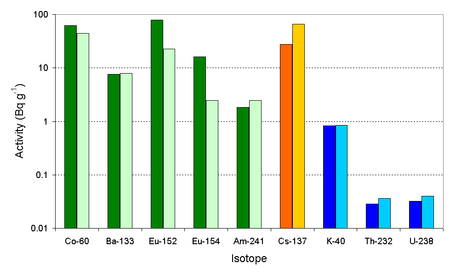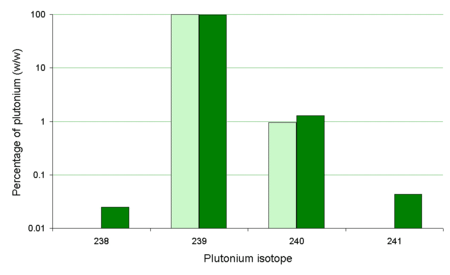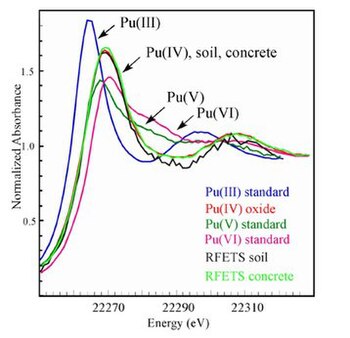Plutonium in the environment
| Part of a series on |
| Pollution |
|---|
 |
Since the mid-20th century, plutonium in the environment has been primarily produced by human activity. The first plants to produce
The majority of
Sources of plutonium
Plutonium production
In the 2013 book[1] on a history of these two blighted cities, Plutopia: Nuclear Families, Atomic Cities, and the Great Soviet and American Plutonium Disasters (Oxford), Kate Brown explores the health of affected citizens in both the United States and Russia, and the "slow-motion disasters" that still threaten the environments where the plants are located. According to Brown, the plants at Hanford and Mayak, over a period of four decades, "both released more than 200 million curies of radioactive isotopes into the surrounding environment -- twice the amount expelled in the Chernobyl disaster in each instance".[2]
Most of this radioactive contamination over the years at Hanford and Mayak were part of normal operations, but unforeseen accidents did occur and plant management kept this secret, as the pollution continued unabated. Even today, as pollution threats to health and the environment persist, the government keeps knowledge about the associated risks from the public.[2]
Bomb detonations


About 3.5 tons of plutonium have been released into the environment by atomic bomb tests. While this might sound like a large amount it has only resulted in a very small dose to the majority of the humans on the earth. Overall the health effects of
Some plutonium can be deposited close to the point of detonation. The glassy
As the 239Pu/240Pu ratio only changed slightly during the Trinity detonation, it has been commented
Bomb safety trials

Plutonium has also been released into the environment in safety trials. In these experiments,
Other related trials were conducted at
Space
Plutonium can also be introduced into the environment via the reentry of artificial satellites containing

Chain reactions do not occur inside RTGs, so a nuclear meltdown is impossible. In fact, some RTGs are designed so that fission does not occur at all; rather, forms of radioactive decay which cannot trigger other radioactive decays are used instead. As a result, the fuel in an RTG is consumed much more slowly and much less power is produced. RTGs are still a potential source of radioactive contamination: if the container holding the fuel leaks, the radioactive material will contaminate the environment. The main concern is that if an accident were to occur during launch or a subsequent passage of a spacecraft close to Earth, harmful material could be released into the atmosphere. However, this event is extremely unlikely with current RTG cask designs.[full citation needed]
In order to minimise the risk of the radioactive material being released, the fuel is typically stored in individual modular units with their own heat shielding. They are surrounded by a layer of iridium metal and encased in high-strength graphite blocks. These two materials are corrosion and heat-resistant. Surrounding the graphite blocks is an aeroshell, designed to protect the entire assembly against the heat of reentering the Earth's atmosphere. The plutonium fuel is also stored in a ceramic form that is heat-resistant, minimising the risk of vaporization and aerosolization. The ceramic is also highly insoluble.[full citation needed]
The US Department of Energy has conducted seawater tests and determined that the graphite casing, which was designed to withstand reentry, is stable and no release of plutonium should occur. Subsequent investigations have found no increase in the natural background radiation in the area. The Apollo 13 accident represents an extreme scenario due to the high re-entry velocities of the craft returning from cislunar space. This accident has served to validate the design of later-generation RTGs as highly safe.
Nuclear fuel cycle
Plutonium has been released into the environment in aqueous solution from
One example of a site where plutonium entered the soil is

Chernobyl
Because plutonium oxide is very involatile, most of the plutonium in the reactor was not released during the fire. However that which was released can be measured. V.I. Yoschenko et al. reported that grass and forest fires can make the caesium, strontium and plutonium become mobile in the air again.[23]
Fukushima
The ongoing crisis at this site includes Spent Fuel Pools on the upper floors, exposed to the elements with complex MOX and plutonium products. The Japanese Government Taskforce has asked for submissions to the International Research Institute for Nuclear Decommissioning[24] in regards to the ongoing Contaminated Water Issues.[25]
Nuclear crime
There have been 18 incidences[
One case exists of a German man who attempted to poison his ex-wife with plutonium stolen from WAK (Wiederaufbereitungsanlage Karlsruhe), a small scale reprocessing plant where he worked. He did not steal a large amount of plutonium, just rags used for wiping surfaces and a small amount of liquid waste. The man was sent to prison for his crime.[27] At least two other people were contaminated by the plutonium.[citation needed] Two flats in Rhineland-Palatinate were also contaminated.[28] These were later cleaned at a cost of two million euro.
Environmental chemistry
Overview
Plutonium, like other actinides, readily forms a dioxide plutonyl core (PuO2). In the environment, this plutonyl core readily complexes with carbonate as well as other oxygen moieties (OH−, NO2−, NO3−, and SO42−) to form charged complexes which can be readily mobile with low affinities to soil.[citation needed]
- PuO2(CO3)12−
- PuO2(CO3)24−
- PuO2(CO3)36−
PuO2 formed from neutralizing highly acidic nitric acid solutions tends to form polymeric PuO2 which is resistant to complexation. Plutonium also readily shifts valences between the +3, +4, +5 and +6 states. It is common for some fraction of plutonium in solution to exist in all of these states in equilibrium.[citation needed]
Binding to soil
Plutonium is known to bind to soil particles very strongly (see above for an X-ray spectroscopic study of plutonium in soil and concrete). While caesium has very different chemistry to the actinides, it is well known that both caesium and many of the actinides bind strongly to the minerals in soil. Hence it has been possible to use 134Cs labeled soil to study the migration of Pu and Cs in soils. It has been shown that colloidal transport processes control the migration of Cs (and will control the migration of Pu) in the soil at the Waste Isolation Pilot Plant according to R.D. Whicker and S.A. Ibrahim.[29] J.D. Chaplin et al. recently reported advances in the Diffusive gradients in thin films technique, which have provided a method to measure labile bioavailable Plutonium in soils, as well as in freshwater and seawater.[30]
Microbiological chemistry
Mary Neu (at Los Alamos in the USA) has done some work which suggests that bacteria can accumulate plutonium because the iron transport systems used by the bacteria also function as plutonium transport systems.[31][32][33]
Biology
Plutonium ingested by or injected into humans is transported in the
Plutonium that is inhaled by humans lodges in the lungs and is slowly translocated to the
See also
References
- ^ a b "Plutopia".
- ^ a b c d Robert Lindley (2013). "Kate Brown: Nuclear "Plutopias" the Largest Welfare Program in American History". History News Network.
- ^ "Plutonium" (PDF). Human Health Fact Sheet. Argonne National Laboratory, EVS. August 2005. Archived from the original (PDF) on 2009-02-25. Retrieved 2009-07-06.
- ^ P.K. Kuroda, Accounts of Chemical Research, 1979, 12(2), 73-78 [1]
- ^ Kuroda, P. K., and Myers, W. A. "Plutonium-244 Dating III Initial Ratios of Plutonium to Uranium in Lunar Samples". Journal of Radioanalytical and Nuclear Chemistry 150, 71.
- ^ Myers, W. A., and Kuroda, P. K. "Plutonium-244 Dating IV. Initial Ratios of Plutonium to Uranium in the Renazzo, Mokoia and Groznaya Meteorite". Journal of Radioanalytical and Nuclear Chemistry 152, 99.
- ^ Kuroda, P. K. "Plutonium-244 in the Early Solar System and the Pre-Fermi Natural Reactor" (The Shibata Prize Awardee's Lecture). Geochemical Journal 26, 1. (1992)
- ^ O. F. X. Donard, F. Bruneau, M. Moldovan, H. Garraud, V. N. Epov, and D. Boust. Analytica Chimica Acta 2007, 587, 170–179
- ^ Radiochemistry and Nuclear Chemistry, G. Choppin, J-O. Liljenzin and J. Rydberg, 3rd Ed, Butterworth-Heinemann, 2002
- ^ P.P. Parekh, T.M. Semkow, M.A. Torres, D.K. Haines, J.M. Cooper, P.M. Rosenberg and M.E. Kitto, Journal of Environmental Radioactivity, 2006, 85, 103-120
- ^ Y. Saito-Kokubu, F. Esaka, K. Yasuda, M. Magara, Y. Miyamoto, S. Sakurai, S. Usuda, H. Yamazaki, S. Yoshikawa and S. Nagaoka, Applied Radiation and Isotopes, 2007, 65(4), 465-468
- ISBN 92-0-101198-9. Retrieved 2009-07-06.
- ^ "Resources (martac report)" (PDF). Archived from the original (PDF) on 2011-03-28.
- ^ "Alan Parkinson - 2000 National Conference - MAPW Australia". Archived from the original on 2008-02-01.
- ^ Attila Vértes, Sándor Nagy, Zoltan Klencsár, Rezső G. Lovas "Handbook of nuclear chemistry", published 2003
- ^ "Energy, Waste and the Environment: A Geochemical Perspective" author R. Gieré, Peter Stille. Page 145.
- ISBN 9264133526.
- doi:10.2172/4689831.
- ^ Grossman, Karl. "Nukes In Space in Wake of Columbia Tragedy". Hieronymous & Company. Retrieved 27 August 2012.
- ^ Clark, David L. (2002-05-29). "Cleanup at Rocky Flats". Los Alamos National Laboratory. Stanford Synchrotron Radiation Lightsource. Retrieved 2009-07-06.
- ^ "Plutonium Contamination Valence State Determination Using X-ray Absorption Fine Structure Permits Concrete Recycle" (PDF). Archived from the original (PDF) on 20 October 2011.
- ^ (Journal of Environmental Radioactivity, 2006, 86, 143-163.)
- ^ "International Research Institute for Nuclear Decommissioning┃TOP Page". Archived from the original on 2013-10-16. Retrieved 2013-10-13.
- ^ "Request for Information (RFI) for Contaminated Water Issues".
- ^ Bunn, Matthew & Col-Gen. E.P. Maslin (2010). "All Stocks of Weapons-Usable Nuclear Materials Worldwide Must be Protected Against Global Terrorist Threats" (PDF). Belfer Center for Science and International Affairs, Harvard University. Retrieved July 26, 2012.
- ^ "Wise Nc; Germany: Plutonium Soup As A Murder Weapon?". WISE News Communique. 2001-10-05. Retrieved 2009-07-06.
- ^ Hoefer, Hagen. "Clean-up of a GBq-Pu contamination of two apartments, contaminated by the Pu theft at the WAK (Pilot Reprocessing Plant - Karlsruhe)" (PDF).
- ^ Journal of Environmental Radioactivity, 2006, 88, 171-188.
- S2CID 237307309.
- ^ Neu, Mary P. (November 26, 2000). "Siderophore-Mediated Chemistry and Microbial Uptake of Plutonium" (PDF). Chemical Interactions of Actinides in the Environment. Los Alamos Science: 416–417. Retrieved 2009-07-06.
- PMID 11478246.
- ^ "Bacterial Biotransformations for the In situ Stabilization of Plutonium" (PDF). April 2005. Retrieved 2009-07-06.
- ^ "Pentetate calcium trisodium injection (Ca-DTPA)". Cerner Multum. Archived from the original on September 28, 2007. Retrieved 2009-07-06.
- ^ ORISE: Radiation Emergency Assistance Center/Training Site
- ^ "Pentetate zinc trisodium injection (Zn-DTPA)". Cerner Multum. Archived from the original on September 28, 2007. Retrieved 2009-07-06.
- ^ "CDC Radiation Emergencies | Radioisotope Brief: Plutonium-239 (Pu-239)". www.cdc.gov. 2022-04-21. Retrieved 2022-06-17.
